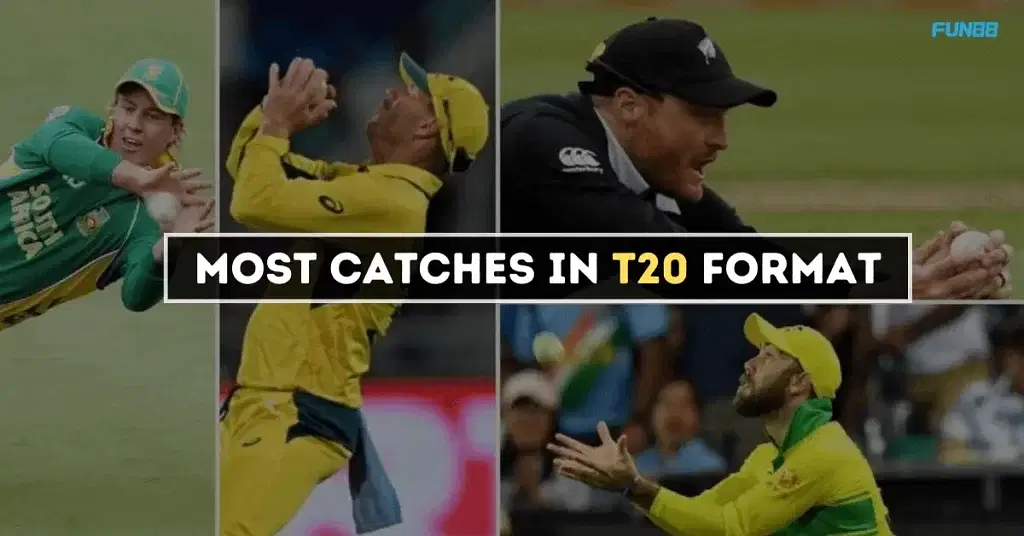In T20 international cricket, a run saved and a catch taken can mean the difference between winning and losing a match. The fielders, however, are often neglected, while bowlers and batsmen receive most of the attention.
Outstanding fielders who can turn a game in a different direction with their quick reactions and perfect catches deserve to be acknowledged.
This blog is dedicated to the performances of such outstanding players who have become masters of fielding in the T20 format, making the most catches and establishing their value on the field.
Most Catches in T20 Cricket
| Player | Span | Mat | Inns | CT | Max | CT/Inn |
| DA Miller (SA/World) | 2010-2023 | 116.00 | 115.00 | 77 | 4 | 0.669 |
| MJ Guptill (NZ) | 2009-2022 | 122 | 121 | 68 | 3 | 0.561 |
| TG Southee (NZ) | 2008-2024 | 123.00 | 121.00 | 65 | 2 | 0.537 |
| Mohammad Nabi (AFG) | 2010-2024 | 121 | 121 | 64 | 3 | 0.528 |
| GH Dockrell (IRE) | 2010-2024 | 130.00 | 127.00 | 62 | 3 | 0.488 |
| RG Sharma (IND) | 2007-2024 | 151.00 | 151.00 | 60 | 3 | 0.397 |
| DA Warner (AUS) | 2009-2024 | 103 | 103 | 58 | 3 | 0.563 |
| V Kohli (IND) | 2010-2024 | 117 | 116 | 52 | 3 | 0.448 |
| AJ Finch (AUS) | 2011-2022 | 103 | 102 | 50 | 3 | 0.49 |
What is the Influence of a Catch on a Cricket Match?
In cricket, catching changes the course of the game. A successful catch eliminates a batsman and creates a lasting psychological impact on both teams.
In the fielding team, a good catch can lift morale and spur momentum, causing a feel-good factor and an increased energy level. On the other hand, the batting team could suffer a dip in confidence especially if the catch is of a key player.
Strategically, getting a set batsman out can temporarily bring the scoring rate down and allow the fielding team to take control of the game. Therefore, catches are vital in determining the outcome of the game and are frequently referred to as the turning points in cricket matches.
Related Read: Best Fielder In The World In Cricket History
Types of Catches
In cricket, catching has many methods suitable for different play conditions and types of ball trajectories. The conventional cup is utilised when the ball is delivered at a waist level or below, the fielders catch the ball with both hands cupped with fingers pointing upwards to secure the ball.
The reverse cup technique is used in high catches whereby the hands are held above the head with fingers facing towards the sky, forming an appropriate cup to catch the ball safely.
Besides these, creative approaches such as the one-handed catch are more often observed in contemporary cricket, showing the quickness and talent of fielders that stretch the boundaries of what can be done on the ground.
The Right Way to Take a Catch
Correct methods are crucial in catching effectively. The success steps are to stand in line with the path of the ball, have the eyes on the ball, and use soft hands to take the impact of the ball which minimises the probability of it bouncing out.
Fundamental footwork is required to position the body as the ball moves, and fielders are instructed to keep their fingers down when taking a low catch and up for high catches.
Moreover, fielding practices are conducted in different match settings, which makes fielders competent and trustful in catching, which is one of the basic skills of professional cricketers.
The Significance of Wearing Sunglasses While Catching in Day Games
In day games, the bright sunlight can cause fielders to become almost blind to the ball, which is why sunglasses are necessary. Quality sunglasses cut the glare and improve contrast so that fielders can see the ball better against the background of a crowd or sky.
In addition, they shield the eyes from UV rays, providing safety while playing. Sunglasses are as important as any technical skill, especially in outfield positions where the ball can be lost in the sun.
Also Read: Top 10 World’s Biggest Stadiums in the World
Conclusion
Fielding, and in particular catching, is critical in the fast-action T20 format where every ball can tilt the match either way. In T20 cricket, some fielders have set themselves apart by their outstanding skill in taking spectacular catches.
Their acrobatics and sharp reflexes amuse the spectators and determine the outcome of the game. Commending these players and their performances by providing the list of the most catches in the T20 format is an appreciation of their role in the sport. It also highlights the importance of fielding in cricket’s shortest format.
Star it if you find it helpful.

